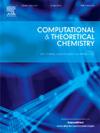Tuning the electronic and adsorption properties of MoSe2 nanosheets by CuO, NiO and pair CuO-NiO metal oxide doping for efficient sensing of caffeine molecule: A DFT study
IF 3
3区 化学
Q3 CHEMISTRY, PHYSICAL
引用次数: 0
Abstract
In this work, the structures and electronic properties of CuO and NiO doped MoSe2 nanosheets are investigated using the density functional theory calculations. The structural stability of these metal oxide doped systems was verified using the binding energy analysis, and thus the CuO doped MoSe2 nanosheets are selected for adsorption and sensing of caffeine molecules. The adsorption energies, density of states, charge density difference, work functions and band structures were examined for the adsorption systems. Caffeine molecules are initially positioned on the CuO clusters of the CuO-MoSe2 nanosheets, and after the adsorption, the O and N atoms are strongly adsorbed to the CuO clusters. Based on band structure calculations, CuO and NiO doped MoSe2 nanosheets exhibited semiconductor property and enhanced conductivity because of band gap reduction. These results provide theoretical basis, which is useful in optimizing and developing novel metal oxide doped MoSe2 nanosheets as sensors for caffeine detection.

通过掺杂 CuO、NiO 和成对 CuO-NiO 金属氧化物调谐 MoSe2 纳米片的电子和吸附特性,以实现咖啡因分子的高效传感:DFT 研究
本文采用密度泛函理论计算方法研究了CuO和NiO掺杂MoSe2纳米片的结构和电子性能。利用结合能分析验证了这些金属氧化物掺杂体系的结构稳定性,从而选择了CuO掺杂的MoSe2纳米片用于咖啡因分子的吸附和传感。考察了吸附体系的吸附能、态密度、电荷密度差、功函数和能带结构。咖啡因分子最初位于CuO- mose2纳米片的CuO簇上,吸附后,O和N原子被强烈吸附到CuO簇上。基于能带结构计算,CuO和NiO掺杂的MoSe2纳米片表现出半导体性质,并且由于带隙减小而提高了电导率。这些结果为优化和开发新型金属氧化物掺杂MoSe2纳米片作为咖啡因检测传感器提供了理论依据。
本文章由计算机程序翻译,如有差异,请以英文原文为准。
求助全文
约1分钟内获得全文
求助全文
来源期刊

Computational and Theoretical Chemistry
CHEMISTRY, PHYSICAL-
CiteScore
4.20
自引率
10.70%
发文量
331
审稿时长
31 days
期刊介绍:
Computational and Theoretical Chemistry publishes high quality, original reports of significance in computational and theoretical chemistry including those that deal with problems of structure, properties, energetics, weak interactions, reaction mechanisms, catalysis, and reaction rates involving atoms, molecules, clusters, surfaces, and bulk matter.
 求助内容:
求助内容: 应助结果提醒方式:
应助结果提醒方式:


